Stellarvue SV130EDT triplet apo refractor on AP-1200GTO mount
Visual back, showing Baader binoviewer and Starlight Instruments FT3035 focuser
Stellarvue SV130EDT
Triplet Apo Refractor Optical Analysis With Test Photos
Wade Van Arsdale
Little Rock, AR., USA
January 22nd-February 27th, 2010
Stellarvue SV130EDT triplet apo refractor on AP-1200GTO mount |
Visual back, showing Baader binoviewer and Starlight Instruments FT3035 focuser |
I. Optical Analysis:
Strehl and Wavefront Error Testing
Test Date: February 27th, 2010
Skies: Clear
Seeing: 6 out of 10, with some interference in atmospheric steadiness from
jet-stream
Transparency: 9 out of 10
Temperature: 40 degrees F
Dewpoint: 34 degrees
Wind: N, 5-10 mph
Test camera: Lumenera SKYnyx 2-2C webcam with Baader IR/UV cutoff filter @
320 x 240 image size, 10 fps capture rate for 1000 frames each, and resolution
of 1.0 arc-sec/pixel
The
SV130EDT tested out with an excellent Strehl value of 0.958, as measured
mid-bandwidth in the Green (approximately 550 nm wavelength). This
corresponds to a P-V wavefront error of approximately 1/9 wave at the camera
chip, which is also impressive. Considering that a P-V value of 1/4 wave
is considered to be diffraction-limited, 1/9th wave is an excellent result for
the SV130EDT and significantly beyond diffraction-limited in optical
performance. This means that in all types of atmospheric seeing conditions
no matter how good, the telescope's performance will only be limited by the
atmospheric seeing itself and never limited by the telescope's optics.
t
The refractor also held up very well as tested separately in the red and blue
bandwidths. It actually tested even better-corrected in the blue bandwidth
than in the reference green tests, at 0.961 Strehl in the blue. Red tested
out at 0.946 Strehl.
Some slight spherochromatic aberration and undercorrection are present in the Roddier images as well as the visual unfocused star test. But both aberrations are well under acceptable limits for a high-quality triplet apochromat and are not detectable *at* focus. This sample did not have any optical aberrations that would be visible in normal imaging or visual use. Overall, the SV130EDT tested out as an excellent performer both visually and for deep-sky imaging as well as for planetary webcamming.
Reference Chart for Strehl Values and P-V Wavefront Errors. Chart courtesy of R.F. Royce Precision Optical Components:
|
Commonly Encountered Wavefront Relationships |
||||
| P-V Fraction | P-V Decimal | Marechal RMS* | Strehl Ratio | Comments |
| 1/3 | .333 | .094 | .71 | |
| 1/4 | .250 | .071 | .82 | Rayleigh Limit |
| 1/5 | .200 | .057 | .88 | |
| 1/6 | .167 | .047 | .92 | Good |
| 1/7 | .143 | .041 | .94 | Very Good |
| 1/8 | .125 | .036 | .95 | Excellent |
| 1/9 | .111 | .032 | .960 (.96) | Excellent |
| 1/10 | .100 | .028 | .969 (.97) | Excellent |
| 1/11 | .091 | .026 | .974 | |
| 1/12 | .024 | .024 | .978 | "Super Apo" |
Strehl
Test Results:
| GREEN (reference): Strehl Test for mid-bandwidth reference (Green--approx. 550nm wavelength) Summary: The Strehl tested at an excellent 0.958, which corresponds to a P-V wavefront error at the camera chip of only 1/9 wave, which is also excellent. Some undercorrection is present in the Ronchigram image (the black and white test pattern below). Slight undercorrection is very typical in many triplet apo refractors and is much more desirable than overcorrection. As the scope's optics cool and equalize, slight undercorrection tends to fix itself to some degree. 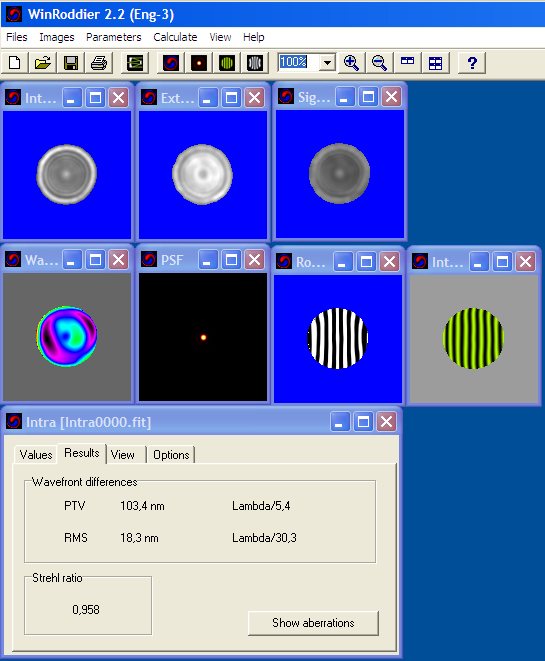 |
RED: Slightly less-corrected in the Red bandwith, but still considered very good with a Strehl value of 0.946, which corresponds to a P-V wavefront error of 1/7 wave or better at the camera chip.
|
BLUE: The scope actually tested out as better-corrected in the blue bandwidth than the reference green bandwith. Blue bandwidth Strehl was 0.961, which is 1/9th wave, P-V, at the camera chip.
|
Strehl Test #2:
For this next test, I selected a star of
significantly different spectral class just to see if there were any variations
in results due to the star color or other end-user variations being introduced
that could affect test accuracy. In the first test above, the Star Pollux
(spectral class K0III-Yellow) was used. For the test below, the star
Alhena (spectral class A0IV- Blue-Green) was used. Both stars were measured
at a sky altitude of +80 degrees to help minimize variations from atmospherics.
Comparison Results:
There were no significant differences in results from Strehl Test #1 to
#2. The largest variance in Strehl results measured between the two tests
was a very small 0.005. This telescope consistently measured around 0.96
Strehl overall in both tests which is excellent. Note, the results in Test
#2 may have been slightly better because the optics had an extra hour to
cool and equalize compared to Test #1 above. Also the atmospheric
seeing conditions for Test #2 were steadier.
| GREEN
(reference): Strehl of 0.960 compared to 0.958 in first test above, for a total variance of 0.002 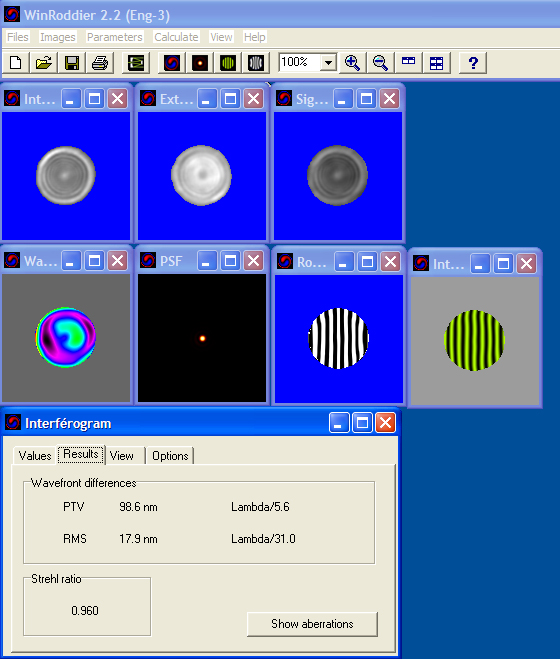 |
RED: Strehl of 0.951 compared to 0.946 above, for a total variance of 0.005 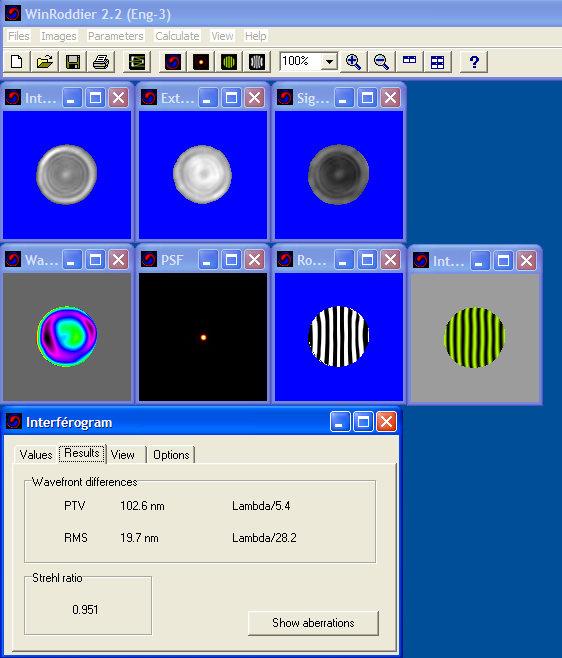 |
BLUE: Strehl of 0.964 compared to 0.961 above, for a total variance of 0.003 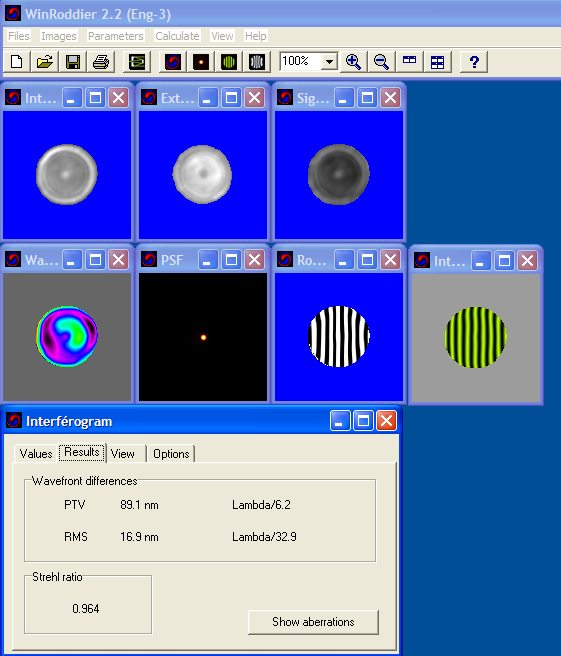 |
II. Hi-resolution webcam images of Mars and the Moon:
Date: February
27th, 2010
Telescope: Stellarvue SV130EDT triplet apo refractor
Camera: Lumenera SKYnyx 2-2C webcam with Baader UV/IR cutoff filter @ 320
x 240 image size, 10 fps capture rate for 1000 frames each, and Televue 4x
Powermate (for Mars shot) with 2x image amplification in the Registax software for a final resolution of
0.125 arc-sec/pixel @ f/56.
Note: for the Mars image, highest resolution was
hindered by unsteady atmosphere caused by presence of jet-stream overhead on
this evening and by the small size of Mars' disk (12 arc-seconds).
Nevertheless, several surface features are visible on the planet's surface due
to the sharp focus, low spherochromatic aberration and undetectable chromatic
aberration of the scope.
For the Moon image, the areas of Mare Nubium, Mare Humorum, and Oceanus Procellarum are shown, along with the major craters Tycho in the upper left corner of the frame, and Copernicus at the bottom center. For this shot, no Powermate was used and the Lumenera camera's maximum screen resolution of 1612 x 1232 pixels was used. The image was cropped down to 800 x 602 pixels for display purposes.
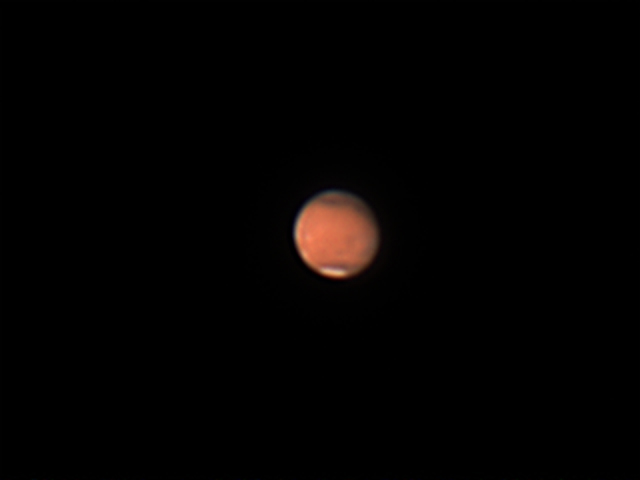 |
 |
III. Collimation Testing and Deep Sky Image Tests
Weather
Conditions:
Test Date: January 17th, 2010
Skies: Clear
Seeing: 7 out of 10
Transparency: 9 out of 10
Temperature: 48 degrees F
Dewpoint: 52 degrees
Wind: None
Equipment:
New Stellarvue SV130EDT 130/900mm focal length triplet apo refractor with Ohara FPL-51
center glass element
Starlight Instruments Feathertouch FT3035 dual-speed focuser with optional Astro-Physics
endcap for rigid screw-down camera attachment
SBIG ST-2000XM CCD camera (15mm image circle and 1600 x 1200 on-screen pixel
matrix) w/CFW8 color filter wheel and AO-8 adaptive optics
Astro Physics AP1200-GTO mount
Test Imaging Run of Messier
50 (image details
here):
M50
was selected to show star shapes, star color, and CA control. M50 is
dominated by blue giant stars. This provides a good test of the optics
to see how well the CA correction is working in the 400-460nm (far blue)
bandwidth. The Curves tool in Photoshop was pushed to near-maximum levels
to show blue fringing. The star colors held up very well, with no
significant halos or color fringing in the blue or other color bandwidths.
This indicates the telescope has very good chromatic aberration control. No Unsharp Mask or other
star sharpening tools were used in this test frame so the native star shapes and
degree of haloing and color aberrations could be assessed easier. Note,
the below image's scale was shrunken to 2.3 arc-seconds per pixel from native
resolution of 1.7 arc-seconds, to allow for easier viewing on lower resolution
LCD screens of 1024 x 768 pixels.
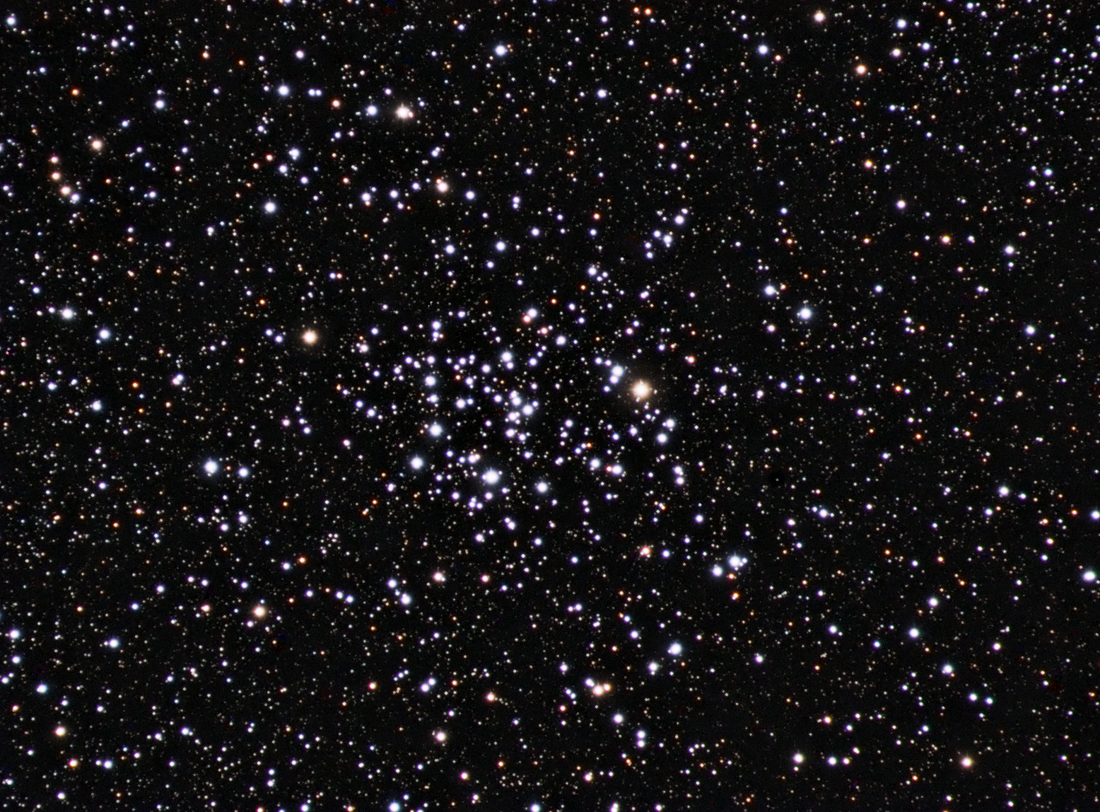 |
IV: CCDI Analysis of the above
object's Luminance-only raw frames @ native resolution of 1.7 arc-sec/pixel:
It
was noticed during some preliminary test shots that some variation in the CCDI
results was coming from the Starlight Instruments FT3035 focuser. It was
discovered that using only the bottom brake screw of the focuser caused some
slight drawtube deflection when fully clamped with the CCD camera mounted (5.8
lbs camera payload weight). The amount of deflection did not show up
visually in the raw frames, only on the CCDI software collimation
analysis. Neither did any drawtube deflection show up on the visual star
test with eyepiece and 2 inch star diagonal mounted instead of the CCD
camera.
Upon further testing, it was discovered that this was easily fixed by also clamping the *top* brake screw as well as the bottom. The image below shows the CCDI on-screen display for collimation results after clamping the drawtube with *both* the top and bottom drawtube brake screws. These results also correlate well with the results seen in the Takahashi Collimator Scope that was used on the SV130EDT to test its collimation (see below). Once the focuser drawtube deflection was corrected, the CCDI software showed collimation from the factory to be basically dead-square on. The screen shots below show almost perfect collimation from the factory after arrival from the shipper.
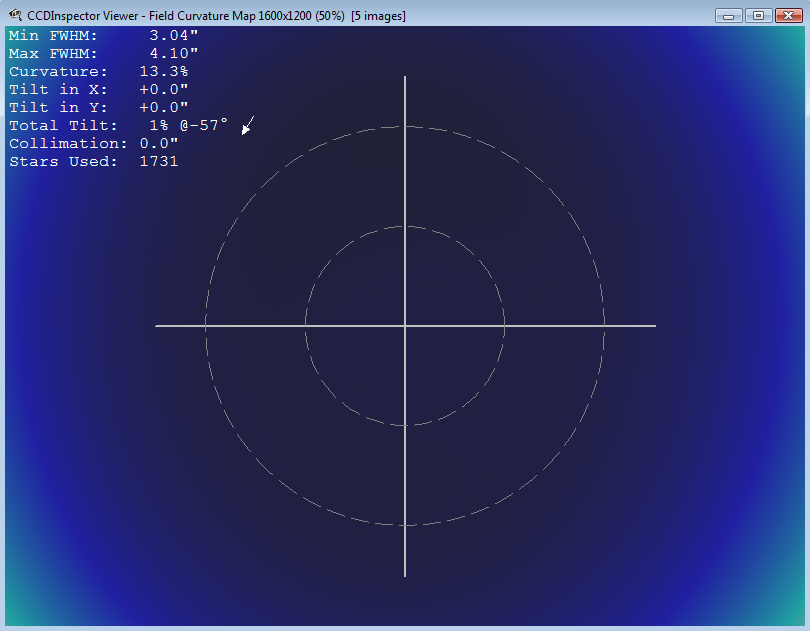 |
Takahashi Collimator Scope
Snapshot:
This
picture is a shot of the actual collimation view through the back end of the
collimator scope itself. It shows the factory collimation of the SV130EDT to be extremely
close to dead-square on, which correlates well with the CCDI analysis above:
 |
Conclusions:
The
SV130EDT triplet apo arrived here very well collimated and in excellent overall
mechanical and cosmetic condition from the Stellarvue shop. The telescope
showed very good control of chromatic aberration in the test imaging run, with no noticeable star haloing or loss of focus in the blue bandwidth or any
other color bandwidths. The SV130EDT also showed nicely low levels of
spherical aberration on the visual star test. This
telescope has a very good performance level for medium-format CCD imaging or visual use either
one.
The SV130EDT was tested for imaging use on a medium-format CCD camera and did very well in the test scenario. I do not have data available yet to assess its performance on APS-sized CCD chips or larger, or the degree of field curvature shown on larger chips than the SBIG ST-2000XM camera that I used for these initial tests. I hope to have some DSLR data soon using a Nikon D200 with APS-sized chip. I also hope to include at least one sample of a Stellarvue field flattener in future tests with an APS-sized chip.
The overall impression I have of this telescope at first light is that it does do what it is marketed and advertised to do, and at a very reasonable price compared to other apochromatic triplet refractors of similar aperture. The SV130EDT is an excellent choice for those wanting to push the visual and imaging performance well beyond what a typical ED doublet refractor can do, but who may not be able to afford the high prices of premium triplet apos at these larger sizes and using the latest FPL-53 glass and most expensive optical designs. The SV130EDT's triplet lens design using an Ohara FPL-51 center element is particularly well-suited for visual deep-sky and planetary or lunar observations with its excellent contrast and sharp focus. At dark-sky sites, the 5 inch aperture is an excellent performer that will give very pleasing visual observations of deep-sky objects.
Wade Van Arsdale
March 4th, 2010
Little Rock, AR., USA